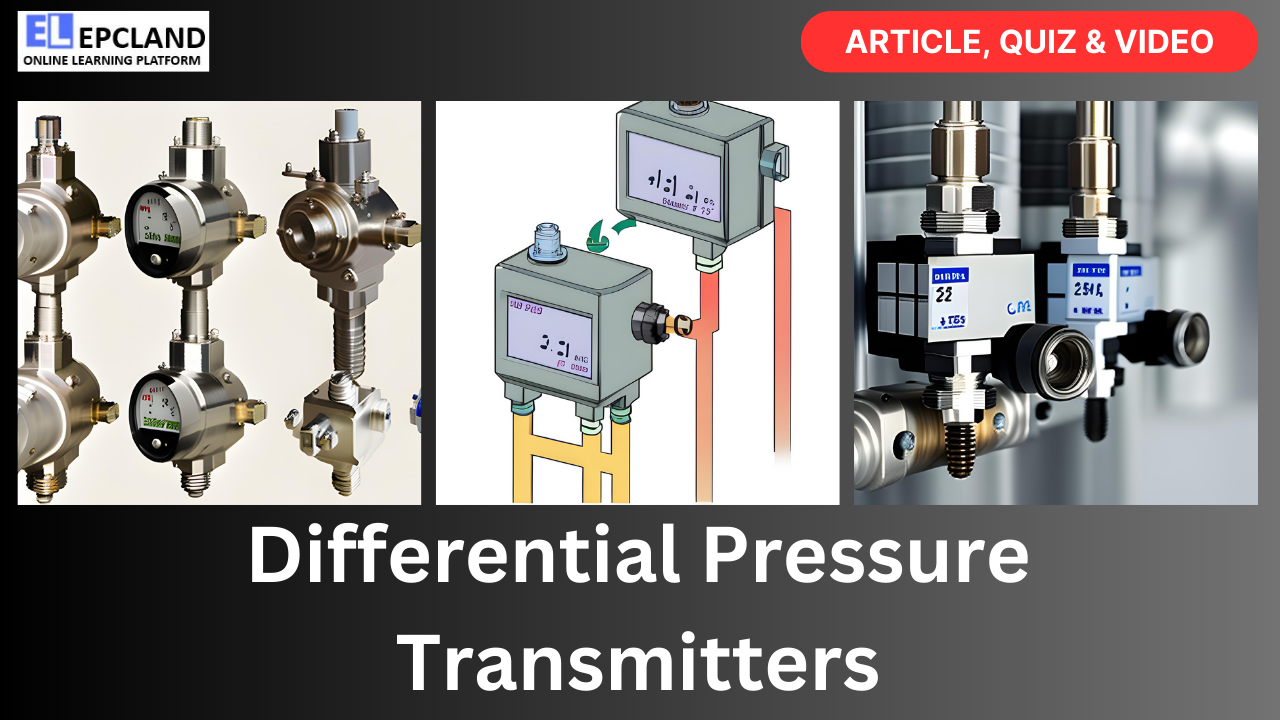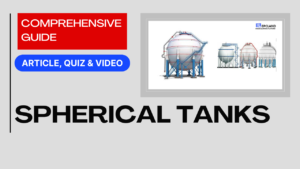In the vast and intricate landscape of the Oil & Gas Industry, precision and control are paramount. Differential Pressure (DP) transmitters are indispensable instruments that play a crucial role in measuring and managing pressure differences within various processes. This article provides an in-depth exploration of Differential Pressure Transmitters, their applications, working principle, and a table summarizing their advantages and disadvantages in the realm of Oil & Gas projects.
Table of Contents
Do not miss the Complete Course on Piping Engineering
By EPCLand
Understanding Differential Pressure Transmitters
What are Differential Pressure Transmitters?
Differential Pressure Transmitters, often abbreviated as DP transmitters or DPTs, are instruments designed to measure the difference in pressure between two points within a system or across a device, such as a valve or filter. This pressure difference, known as differential pressure, is a key parameter in many industrial processes, particularly in the Oil & Gas Industry.
Working Principle of Differential Pressure Transmitters
The working principle of a DP transmitter is based on the concept of a pressure difference causing a deflection in a measuring element. Here’s a simplified explanation of how it works:
- Sensing Element: The heart of a DP transmitter is its sensing element, which is typically a diaphragm or a bourdon tube. It is located between the two pressure ports—one port connected to the high-pressure side and the other to the low-pressure side of the system.
- Pressure Difference: When there is a pressure difference between the two ports, it causes a mechanical deflection in the sensing element. This deflection is proportional to the difference in pressure.
- Transduction: The mechanical deflection of the sensing element is then transduced into an electrical signal using various mechanisms, such as piezoelectric crystals or strain gauges. This electrical signal is typically in the form of a voltage or current.
- Output Signal: The electrical signal is conditioned and amplified by the electronics within the DP transmitter, resulting in an output signal that corresponds to the differential pressure being measured. Common output signals include 4-20 mA analog signals and digital signals such as HART or FOUNDATION Fieldbus.
Applications of Differential Pressure Transmitters in Oil & Gas Projects
DP transmitters are versatile instruments with a wide range of applications in the Oil & Gas Industry. Here are some key areas where they are used:
1. Flow Measurement
One of the primary applications of DP transmitters is in flow measurement. By placing an obstruction, such as an orifice plate or venturi tube, in a pipeline, the pressure drop across it can be measured using a DP transmitter. This pressure drop is directly proportional to the flow rate, allowing for accurate flow measurement.
2. Level Measurement
In tanks, vessels, and storage facilities, DP transmitters are employed to measure the level of liquids or granular materials. The pressure at the bottom of the tank and the pressure at the liquid or material surface are sensed by the DP transmitter. The difference in pressure indicates the level.
3. Pressure Differential Across Filters
In processes where filtration is critical, DP transmitters are used to monitor the pressure drop across filters or strainers. A sudden increase in pressure drop can indicate a clogged or deteriorating filter, prompting maintenance actions to prevent equipment damage.
4. Valve and Control Valve Monitoring
Control valves play a vital role in regulating the flow of fluids in the Oil & Gas Industry. DP transmitters are installed upstream and downstream of control valves to monitor the pressure drop across the valve. This information is crucial for valve performance assessment and control loop optimization.
5. Density and Specific Gravity Measurement
DP transmitters can be employed to measure the density or specific gravity of fluids. By comparing the differential pressure in a fluid with a known reference, the density can be accurately determined, which is valuable in custody transfer applications.
6. Differential Pressure Safety Systems
In safety-critical applications, such as relief valve monitoring or emergency shutdown systems, DP transmitters provide real-time information about pressure differentials. In the event of an anomaly, these systems trigger safety protocols to prevent accidents.
Key Advantages of Differential Pressure Transmitters
Advantages
| Advantages | Description |
|---|---|
| 1. High Accuracy and Precision | DP transmitters are renowned for their accuracy and precision in measuring pressure differences. They can provide reliable measurements even in challenging conditions. |
| 2. Versatility | The versatility of DP transmitters is a significant advantage. They can be adapted to various applications by selecting the appropriate sensing element, pressure range, and configuration. |
| 3. Durability | Oil & Gas projects often operate in harsh environments with extreme temperatures and pressures. DP transmitters are built to withstand these conditions, ensuring long-term reliability. |
| 4. Compatibility with Standard Protocols | Many DP transmitters are equipped with communication protocols like HART (Highway Addressable Remote Transducer) and FOUNDATION Fieldbus, allowing for seamless integration into modern process control systems. |
| 5. Real-time Monitoring and Diagnostics | Advanced DP transmitters offer real-time monitoring and diagnostic capabilities, enabling predictive maintenance and reducing downtime. |
Do not miss the Complete Course on Piping Engineering
By EPCLand
Disadvantages
| Disadvantages | Description |
|---|---|
| 1. Installation and Maintenance | Proper installation and maintenance are crucial for accurate performance. Incorrect installation or neglecting maintenance can lead to inaccuracies. |
| 2. Sensitivity to Vibration | DP transmitters can be sensitive to vibrations and mechanical shocks, potentially affecting measurement accuracy. |
| 3. Initial Cost | High-quality DP transmitters can have a significant initial cost, although this cost is often justified by their accuracy and reliability. |
| 4. Complex Calibration | Calibration can be complex, especially for applications with extreme conditions or stringent accuracy requirements. Skilled technicians are often required. |
| 5. Limited for Low Differential Pressures | DP transmitters may not perform optimally for very low-pressure differentials, where other measurement methods may be preferred. |
Safety and Reliability Considerations
In the Oil & Gas Industry, safety is paramount. DP transmitters play a vital role in maintaining safety through various applications, such as monitoring relief valves, safety showers, and emergency shutdown systems.
1. Safety Instrumented Systems (SIS)
Safety Instrumented Systems are designed to prevent or mitigate potentially dangerous situations. DP transmitters are often integrated into SIS to continuously monitor pressure differentials and trigger safety actions when predefined thresholds are exceeded.
2. Functional Safety Standards
Oil & Gas projects adhere to functional safety standards, such as IEC 61511 or ISA 84, which provide guidelines for the design, implementation, and operation of safety instrumented systems. DP transmitters used in safety-critical applications must comply with these standards.
3. Redundancy and Voting
In critical safety applications, redundancy is commonly employed. Multiple DP transmitters are installed, and their signals are compared. If discrepancies are detected, a voting system ensures that the correct action is taken to maintain safety.
4. Regular Testing and Maintenance
Safety systems, including DP transmitters, require regular testing and maintenance to ensure they perform as expected in emergency situations. Functional tests and proof tests are conducted to verify proper operation.
Future Trends in Differential Pressure Transmitters
As technology advances, so do the capabilities of DP transmitters. Several future trends are shaping the evolution of these crucial instruments in Oil & Gas projects:
1. Wireless DP Transmitters
The adoption of wireless technology allows for more flexible installation and monitoring of DP transmitters, particularly in remote or hazardous locations.
2. Enhanced Diagnostics and Predictive Maintenance
Advanced DP transmitters are incorporating more sophisticated diagnostics and predictive maintenance capabilities. These features enable early detection of issues, reducing downtime and maintenance costs.
3. Digital Twins and Simulation
Digital twin technology is being used to create virtual replicas of physical assets, including DP transmitters. These digital twins enable real-time monitoring, optimization, and troubleshooting.
4. Integration with Industrial IoT (IIoT)
DP transmitters are becoming integral components of Industrial IoT (IIoT) ecosystems. They contribute to the collection of vast amounts of data for analysis and decision-making.
Conclusion
Differential Pressure Transmitters are indispensable tools in Oil & Gas projects, providing critical measurements of pressure differentials that drive various processes and safety systems. Their accuracy, versatility, and durability make them integral components of the industry’s infrastructure.
Selecting the right DP transmitter, ensuring proper calibration, and adhering to safety standards are essential steps in harnessing the full potential of these instruments. With the evolution of technology, DP transmitters are poised to play an even more significant role in optimizing processes, enhancing safety, and contributing to the efficiency and sustainability of Oil & Gas operations.
As the Oil & Gas Industry continues to evolve, so will the capabilities of DP transmitters, keeping them at the forefront of innovation and progress in this dynamic field.
FAQs
- What is the primary purpose of a Differential Pressure Transmitter in the Oil & Gas Industry?Differential Pressure Transmitters in the Oil & Gas Industry are primarily used to measure and monitor pressure differences within various processes. They play a critical role in applications such as flow measurement, level measurement, and safety systems by providing accurate data on pressure variations.
- How does a Differential Pressure Transmitter work, and why is it suitable for measuring pressure differences?A Differential Pressure Transmitter works on the principle of measuring the deflection of a sensing element caused by the difference in pressure between two points. It converts this mechanical deflection into an electrical signal, which is proportional to the pressure difference. This instrument is suitable for measuring pressure differences because it provides highly accurate and precise measurements, making it ideal for critical applications in the Oil & Gas Industry.
- What are the advantages of using Differential Pressure Transmitters in Oil & Gas projects?Some advantages of using Differential Pressure Transmitters include their high accuracy and precision, versatility for various applications, durability in harsh conditions, compatibility with standard communication protocols, and real-time monitoring and diagnostic capabilities. These advantages contribute to improved process efficiency and safety.
- What are the typical applications of Differential Pressure Transmitters in the Oil & Gas Industry?DP transmitters find applications in a range of Oil & Gas operations. They are commonly used for flow measurement, level measurement in tanks and vessels, monitoring pressure differential across filters, control valve performance assessment, density and specific gravity measurement, and in safety systems for emergency shutdown and relief valve monitoring.
- What safety considerations should be taken into account when using Differential Pressure Transmitters in Oil & Gas projects?Safety is a top priority in the Oil & Gas Industry. When using DP transmitters, it’s crucial to adhere to functional safety standards, perform regular testing and maintenance, and consider redundancy and voting systems for critical safety applications. Proper installation, calibration, and compliance with safety protocols are essential to ensure the reliability of DP transmitters in maintaining safety in the industry.
Do not miss the Complete Course on Piping Engineering
By EPCLand
Recommended courses (Published on EPCLand)
- Basics of Piping Engineering
- Piping Layout Engineering
- Piping Material Engineering
- Piping Stress Analysis
- Complete Course on Piping Engineering
- Material Requisitions
- Piping Material Specifications
- Valve Material Specifications
Don’t miss the published articles on following:
Related Video
Attempt Quiz
Question 1:
What is the primary function of a Differential Pressure Transmitter in oil & gas projects?
Explanation: The primary function of a Differential Pressure Transmitter in oil & gas projects is to measure the pressure difference across a flow restriction, which is used to determine flow rate.
Question 2:
What units are commonly used to express the output of a Differential Pressure Transmitter?
Explanation: The output of a Differential Pressure Transmitter is commonly expressed in units such as pounds per square inch (psi) or Pascal (Pa).
Question 3:
What is the purpose of a diaphragm in a Differential Pressure Transmitter?
Explanation: The diaphragm in a Differential Pressure Transmitter is used to transmit the pressure difference across a flow restriction to the sensing element, where it is converted into an electrical signal.
Question 4:
Why are Differential Pressure Transmitters important in oil & gas projects?
Explanation: Differential Pressure Transmitters are important in oil & gas projects because they provide critical data for process control and safety, helping to optimize operations and prevent accidents.
Question 5:
What is the typical installation location for a Differential Pressure Transmitter in a pipeline?
Explanation: A Differential Pressure Transmitter is typically installed near pressure relief valves or at strategic locations along a pipeline to measure pressure differences.



